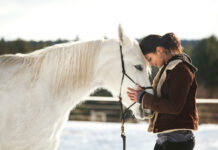
Quick Decisions
Horses rely on all their senses to make decisions in a flash. Their keen senses help them know whether they are safe or need to run.
Horses have more peripheral vision than humans do, and they are keyed in to sense small changes in their environments. They can smell a change in the air and smell when dinner is coming. Their sense of taste helps them know what is safe.
What your horse senses from the environment will tell him how he should behave. Should he be calm because all is going as usual? Or on guard because the bushes moved or there is a new smell or taste? Is he agitated because a blanket doesn’t fit right or his new tack feels different?
If there’s the slightest distraction, your horse may be tuned in to what he’s feeling and not focused on you.
The Wind Takes Away
On windy days, horses suddenly can’t rely on the senses they trust and their behavior can change dramatically. While a horse usually could hear a predator in the bushes getting ready to pounce, in the wind everything rustles. When the air is calm, he can see little changes with his eyes, but when the wind moves everything at once, it’s hard to see what is a threat and what movement is inconsequential. Without that information, a horse will be more on guard.
Some horses are more sensitive than others. On a stormy day, a horse may be edgy and tense. He already feels like something will go wrong.
If you’re riding along and your horse spooks at something, jostling you in the saddle, he may feel that change of weight as added pain. In your shock at the spook, you may also pull hard on the reins.
The horse that was already worried that something would happen has now had his fears realized. When he becomes fearful of fear, that’s a hard training issue to overcome.

When to Call it Off
When should you expect your horse to work well no matter the weather, and when should you call it off?
If you’re training a new horse, riding in the wind may not be worth it. If you had a big breakthrough in your last training session, it’s not worth training in a windy, sense-depriving environment that may cause your horse to behave differently than he could otherwise.
If you have a well-trained horse, you may make a different choice.. I have ridden my horses in all kinds of inclement weather. However, I don’t want to push a horse that is just learning or at a tenuous place in his training.
Ultimately, you are the one in your partnership that can weight the pros and cons and make an executive decision. I tend to err on the side of caution.
The Eyes Have It
The horse’s large, wide-set eyes are his No. 1 sensory receiver. Horses’ distance vision is very good; their closer vision is not as clear. The horse has very little binocular vision (seeing with both eyes at once), and he can only see the ground in front of him when his head is down. To see in the distance, he must lift his head. He’ll raise his head when he’s nervous so that he can see farther away.

In training horses, we want to keep the horse’s head low so that they aren’t looking for something to be afraid of. Asking the horse to lower his head with intention can help a horse calm down since he doesn’t see something more to worry about.
A horse’s depth perception is not great. He may not be able to tell the difference between a puddle and a deep hole, and may react to anything he sees as a change in footing. The horse isn’t acting maliciously when he sidesteps if he sees a change in footing.
Horses also have vision trouble when it comes to changes in light. Their pupils dilate more than a humans’. If you turn a light on in the barn in the middle of the night, the horse’s eyes don’t adjust quickly.
Likewise, a horse going from bright light to a dark location can’t easily transition—that’s what makes a trailer a scary place to step into. He can’t see well and may fear what could be in there that he can’t perceive.
As we think about how a horse takes in information—and how different it is from how humans sense the world—it will make us better horsemen to understand why the horse acts the way he does.
This article originally appeared in the March 2017 issue of Horse Illustrated magazine. Click here to subscribe.





